Not sure which harness to buy for your pug? Keep reading to learn how to choose a safe and comfortable harness, along with our list of the best harnesses for pugs.

Contents
With their short necks, skin folds, and barrel-chests, it’s clear that pugs have unique harness requirements.
Pugs are also excitable dogs with a habit of slipping collars and harnesses. Aside from leading you on an embarrassing chase around the dog park, an escaped dog is at risk of being hit by cars or getting lost.
For these reasons, pug owners need to think carefully when choosing a harness. A harness for pugs should be secure, comfortable, and adjustable. It should also give you control of your pet without putting excessive strain on the dog’s neck.
In this article, I’ll discuss what to look for in a harness for pugs. I’ve also listed five of the best pug harnesses to help you make an informed choice.
Our #1 Pick: Puppia RiteFit Dog Harness
Soft & comfortable harness that’s easy to adjust to a pug’s body
My top pick for a pug harness is the excellent Puppia RiteFit. It’s a relatively cheap harness, but has a comfortable mesh design and is available in a variety of colors. It also has both adjustable neck and chest straps.
Why Are Harnesses Safer for Pugs?

I recommend walking any dog on a harness rather than a collar – but this advice is doubly important for pugs.
An obvious issue is that pugs can easily slip out of collars when attached to a leash. This could be dangerous if near roads or other dogs.
A bigger problem is that collars put force directly onto the dog’s windpipe. Pugs are a brachycephalic breed, so they already struggle to breathe due to a short snout, narrower airways and flat face. Even light pulling on a collar can make breathing problems worse.
Pugs, like many small dogs, also have delicate necks. The force of a collar can cause serious damage – including spinal injuries and even tracheal collapse – especially if your dog suddenly jerks the lead.
Evidence suggests that collars can cause thyroid problems, as they press directly on the thyroid gland. Pulling on a collar has even been linked to increased risk of eye glaucoma.
In short, walking on a collar is a bad idea for pugs!
Instead, I recommend using the collar exclusively for your dog’s ID tag, and a harness for the leash attachment.
Harnesses are much safer (especially for small breeds), as force is spread across the shoulder and chest. You also have more control without worrying about hurting your pet. If your dog lunges at a person, animal or other dog, you can maintain control without worrying about damaging his throat.

Why You Should Never Use a Choke, Prong or Other Aversive Collar
At The Dog Clinic, we don’t think aversive collars are humane. This includes choke, prong and half-check chains. Aside from damaging the bond between you and your dog, these collars have been linked to spinal injuries, whiplash, paralysis and asphyxiation, amongst other things.
While aversive collars are dangerous and unfair for all dogs, they are particularly unsafe for brachycephalic breeds or those with delicate necks. You should never use them on a pug.
Long-term positive training is the best way to stop your pug from pulling. But if you want to discourage it in the short-term, look for a harness with a front-leash attachment (“no pull dog harness”), such as the Ruffwear Front Range. These guide your dog in a circle when they pull.
Choosing the Right Harness For Your Pug
There are plenty of excellent harnesses on the market, but not all are suitable for a pug. Here are some tips for choosing the right harness.
Size

Whichever harness you choose, getting the right size is essential for keeping your pug safe and comfortable.
A too small harness will rub and restrict your dog’s movement, while too big can chafe and make it easier to escape. Pugs also tend to have necks larger than their head, making it easier for them to slip out of a harness that’s not properly fitted.
Choosing the right size isn’t always easy though. Sizing for a pug’s barrel chest can sometimes mean the harness is too long. You may also need to account for thick neck folds.
All high-quality harnesses have a sizing chart with measurements for neck and chest girth. Never rely on weight alone, as an 18-pound pug has a very different body shape to other dogs of the same weight!
If in doubt, or if your dog falls between two sizes, get the bigger option. You can always exchange it for the smaller option if it doesn’t provide a perfect fit.
Other Factors to Consider
Aside from sizing, there are several other considerations when choosing the best pug harness. These include:
- Material. Nylon harnesses after often best for pugs. This material is strong, lightweight and weather resistant. Nylon webbing is also less likely to rub or cause skin irritation.
- Adjustability. Many harnesses only have adjustable chest straps. Buying a harness with both adjustable neck and chest straps makes it easier to get a snug fit on your pug.
- Buckle Type. Quick-release buckles are usually the best option for a pug harness. They make it easy to get the harness on and off quickly.
- Padding. The amount of padding varies depending on the harness. Some harnesses only have basic straps, while others have extensive padding across the chest and underarms.
- Durability. Your dog’s harness needs to withstand pulling, snagging, wet weather and much more. Look for strong seams, reinforced D-rings, and sturdy buckles.
- Leash Attachments. All harnesses have rear leash attachments, and these are fine for most situations. Front D-rings can be useful for discouraging pulling, however, as the dog is guided in a circle rather than where he wants to go.
Note: Harnesses should only be worn on walks. They can be uncomfortable to wear for long periods and may affect the health of your pug’s coat.
Car Safety
The vast majority of dog harnesses have not been designed to withstand a car crash. Many have seatbelt loops, but these are unlikely to protect your pup in an accident.
For car travel, only buy a harness that’s been crash-tested. You can see our list of the best car harnesses here.
Our Top 5 Picks
Now you know what to look for in a harness for your pug, here are five of my top picks for this breed. Please read each review carefully to find the best harness for your pug.
I think the Puppia RiteFit is an excellent harness for pugs. It’s strong, has several adjustment points, and is available for a great price. If you’re not sure which harness to buy for your pug, the RiteFit is a great place to start.
While the basic Puppia harness is a popular choice, I much prefer the RiteFit – especially for pugs. The main difference is that the RiteFit has both adjustable neck and chest straps, which I’ve found makes it easier to get a comfortable fit for your pug. It’s also one of the best harnesses for adjusting to a pug’s unique shape and minimising breathing issues.
Aside from the adjustable design, the RiteFit is made with breathable mesh that helps keep your pup cool and dry. It also has quick-release buckles (making it easy to put on), two rear leash attachments, and is available in a range of colours.
Most importantly, I’ve found that the Puppia Ritefit does a good job of spreading force across the chest and reducing pressure on the neck. This is essential for pugs with breathing issues.
There aren’t many drawbacks to the RiteFit – especially for the price. It doesn’t have a reflective trim like some of the other harnesses on this list, however, which makes it less suitable for walking in low light conditions.
The Puppia RiteFit is my top recommendation for a pug harness. It’s strong, inexpensive, and can be adjusted to a pug’s unique body shape. It’s also available in a range of fun colours (including pink!)
- Leash Attachment: Rear
- Price Range: $
- Adjustable neck and chest straps
- Quick-release buckles
- Spreads force across chest
- No reflective trim
If your pug is an escape artist, the Ruffwear Webmaster is one of the most secure harnesses on the market. The extra rear strap makes it almost impossible to “back out” – plus it’s highly durable and has a handle for extra control.
The Ruffwear Webmaster is a tough harness that’s perfect for dogs that have a habit of escaping. Unlike most harnesses, it has an extra rear strap to keep your pup secure and safe, along with a reflective trim and handle for extra control.
It also has plenty of padding. Each strap has a foam covering to prevent rubbing, while the 5 adjustment points allow you to get a snug fit.
I’ve noticed a few downsides to this harness though. The Webmaster is considerably more expensive than the Puppia RiteFit. It’s also bulky, so not all dogs enjoy wearing it, and fiddly to adjust compared to other harnesses.
I also wish it had a front leash attachment, like the Ruffwear Front Range (see below). There are two leash attachments, but both are on the back.
Even so, the Ruffwear Webmaster is a highly durable harness that’s brilliant for preventing escapes. If you need a strong and secure pug harness, this is my top recommendation.
The Ruffwear Webmaster is a strong harness that’s designed to prevent escapees. If your pug has a habit of “backing out” of his harness, the Webmaster is likely to solve the problem. It also has 5 adjustment points and lots of padding.
- Leash Attachment: Rear
- Price Range: $$$
- 5 adjustment points
- Extra rear strap to prevent escapes
- Strong
- Expensive
- No front leash attachment
The Ruffwear Front Range dog harness is a popular choice for pugs – especially those that pull. It has a front leash attachment point to discourage pulling, along with lots of padding and an easy-to-adjust design.
With adjustable neck and belly straps, I’ve found the Front Range is easy to fit to your pug’s body shape. It also has plenty of padding across the chest to keep your dog comfortable and protect his throat.
An interesting feature of the Front Range is the front leash attachment. This is a fabric loop that can be used to discourage pulling without causing pain. Other features include an ID storage pocket, reflective material in the trim, and several colour options.
The Front Range could also be a good choice if the Ruffwear Webmaster is too bulky for your pug. The lack of a third strap makes it more likely that your dog can back out, but also reduces the weight.
While the Front Range is an excellent harness, there are a few downsides. I wish the front attachment was metal rather than fabric for extra durability. It’s also more expensive than the Puppia RiteFit.
The Ruffwear Front Range dog harness is one of the best all-rounders on the market. It’s lightweight, has lots of padding, and four adjustment points. It also has a front leash attachment to discourage pulling.
- Leash Attachment: Front and Rear
- Price Range: $$
- 4 adjustment points
- Front leash attachment
- Strong
- Expensive
- Front D-ring is only fabric
The Julius-K9 IDC is one of the most durable dog harnesses on the market. It’s also adjustable, has quick release buckles, and a reflective design.
I’m a big fan of the Julius-K9 dog harness. It’s tough and durable, yet has a simple design and is comfortable for almost any dog to wear.
There are two adjustable straps on the front and belly. This makes it easy to fit a pug – although be careful to choose the right size as there are plenty of options.
Like all the best pug harnesses, the IDC does a great job of spreading force across the chest to prevent choking. The quick-release buckles make it easy to take on or off, and the reflective edges improve visibility.
It’s not the best dog harness for preventing escape artists though. Adjusting the Velcro front strap can also be difficult unless you take off the harness.
If you need a strong and simple harness for a pug, the Julius-K9 is an excellent choice. It’s one of the toughest heavy duty harnesses on the market and helps protect your dog’s throat.
- Leash Attachment: Rear
- Price Range: $$
- Tough and durable harness
- Two adjustable straps
- Quick-release buckles
- Expensive
- Adjusting Velcro strap can be fiddly
Most of the other harnesses on this list have padded designs. This increases comfort, but some dogs prefer a lighter design. If that sounds like your pug, the Buddy Belt Classic could be a good alternative.
The Buddy Belt is a simple harness that’s designed to reduce stress on the neck compared to collars. It has a single buckle, making it easy to put on, and is made with durable leather. It’s a flat buckle though – not a quick-release.
One of the main advantages of the Buddy Belt is its minimalist design. For dogs that don’t enjoy wearing bulky harnesses, it’s a good choice.
There are a few things to be aware of though. The Buddy Belt doesn’t have as much padding as other options, so it’s not as suitable for strong pullers. As with all leather harnesses, it’s prone to stretch over time, so make sure you regularly check the sizing.
It’s also expensive – especially compared to the Puppia RiteFit.
Note: You can also buy a vegan leather version of the Buddy Belt.
The Buddy Belt is a leather harness with a simple design. It’s not the best for pullers and may stretch over time, but could be a good option if your dog hates bulky harnesses.
- Leash Attachment: Rear
- Price Range: $$
- Simple leather harness
- Single buckle
- Expensive
- Leather can stretch over time

Frequently Asked Questions
Which Collars Should I Choose for a Pug?
Collars with quick-release buckles are best for pugs. They are easier to take off than those with belt buckles.
You may also want to consider a breakaway collar – assuming you’ll be using a harness for walking. These “break” if put under too much force, which can be safer if there’s a chance of your pet being caught on a fence or other object in the home.
Which Harness For a Pug Puppy?
Pug puppies, or puglets as they are sometimes known, can wear the same harnesses as adult pugs. The key is to get the right size and to avoid restricting the puppy’s movements.
My favourite option for pug puppies is the Puppia RiteFit. It’s comfortable, lightweight, and easy to adjust – plus it makes sense to choose a cheaper harness as you’ll probably need to replace it before your dog is fully grown.
Make sure you check the sizing regularly. Puppies grow fast!
What If My Pug is Scared of His Harness?
It’s common for a dog to be scared of a new harness – especially if he’s never worn one before.
If your dog is scared, don’t force him to wear the harness straight away. This will just create more negative feelings towards the harness. Instead, use a simple desensitization program to help your pug enjoy wearing it.
Start by leaving the harness near him and giving him treats when he goes near it. Gradually build up to moving the harness closer, gently touching him with it, and then putting it on for short periods, while giving plenty of treats and praise to create positive associations. This process could take several days or even weeks, so don’t rush.
For a more detailed overview, check out our guide to teaching a fearful dog to enjoy wearing a harness.
Summary
Pugs have a unique body shape. Their barrel chests, skin folds, and short neck can make it difficult to choose a harness that’s both comfortable and secure.
My top pick for a pug harness is the excellent Puppia RiteFit. It’s a relatively cheap harness, but comes with adjustable chest and neck straps to get a snug fit on your pug. It’s also soft and comfortable to wear.
Do you have any questions about choosing the best harness for pugs? Please let me know in the comments section below.






